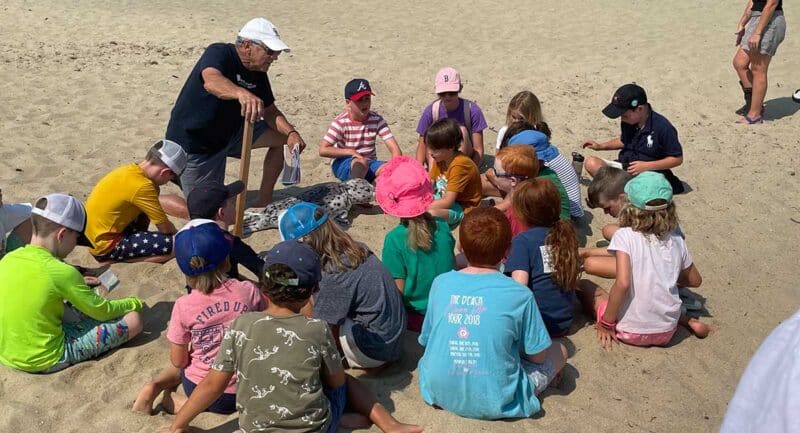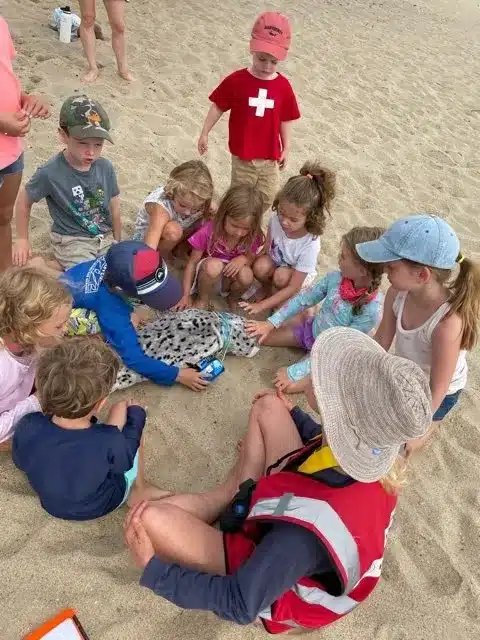by Pam Murphy
Have you noticed seals lying around on the beach? Do you know what to do if you see one? Are they ok? Should I pour water on him? Shoo him back into the ocean? Get up close and see if he’s breathing? Take a selfie with him because I can? None of the above! The answer is stay back 150 feet and call the Marine Mammal Alliance Nantucket Hotline (833-667-6626). Their trained volunteers will advise you, ask for observations and then send a teammate out to check.
Marine Mammal Alliance Nantucket (MMAN) is a local non profit, permitted by the National Oceanographic and Atmospheric Administration to protect and rescue all marine mammals around Nantucket, Tuckernuck, and Muskeget. The Marine Mammal Protection Act of 1972 makes it illegal for anyone else to approach seals, whales, dolphins, and other marine animals. Before that, seals were killed indiscriminately by people acting under the false premise that they were hampering the fishing industry. People could present a seal snout and earn $5. Populations declined drastically and the natural balance of the ocean ecosystem was compromised. So the MMPA was born, and it has taken all these many years to get populations back to historic levels.
Gray seals, or Halichoerus grypus, which means “hooked nose pig of the sea,” are part of the “true” seal family, and the ones most often seen on Nantucket. All true seals have short flippers and no external ear flaps. Many Gray Seals are seen around Nantucket in winter when they are having their pups, through the spring molt. Males can be as large as 880 lbs and females 550 lb. Moms have one pup on the beach after 11 months gestation and will nurse him for three weeks. Once weaned, the pups lose their cozy white lanugo coat and have to learn to swim and fish on their own. It’s a risky business, and up to 50% don’t survive. Since Nantucket beaches are accessible to vehicles, the MMAN team does their best to protect pups from vehicle traffic using signs and orange cones and making sure they are not abandoned by mom during that crucial nursing time. Too much human interaction will cause mom to not come back.
Once the pups are fattened up on rich mother’s milk, they are on their own and must hone their swimming and hunting skills. These juveniles will get themselves into trouble encountering all imaginable types of dangerous situations. Nature takes her course and balances populations with predators, parasites, and illness, but the MMAN team tries to mitigate the effects of human behavior. We can send an animal with propellor wounds to rehab at the National Marine Life Center, but mostly the team spends the spring months capturing young seals caught in rope, gill net, twine, ring frisbees, and other marine debris. It’s a daily struggle to keep up with all the victims and try to help. Disentangling entails dropping everything when the call comes in to get to the animal before he is frightened into the water. Once swimming again, we have no chance.
With nets, animal handling gloves and a variety of cutting tools, volunteers capture and restrain the animal, and another volunteer or two will approach to remove the offending debris. Without these efforts by stranding teams up and down the Eastern Seaboard, entangled animals drown or are slowly strangled, often with gill netting cutting deeper and deeper into their flesh as they grow. NOAA is working with the fishing industry to try to mitigate these occurrences with all marine mammals and especially the endangered North Atlantic Right Whale. With fewer than 340 left on the planet and barely over 100 breeding females, the threat of entanglement and ship strikes is devastating.
So back to our list of “Don’ts” above: Why should I not throw water on a seal on the beach? A. These animals haul out onto the beach to rest, digest and regulate their body temperatures. Your well-meaning gesture would put an end to all of that. Plus, it’s against the law to get that close. Your presence should not change his behavior or scare him back into the water. A seal may spend several days hauled out.
To gauge the proper distance of 150 feet, think three school bus lengths. Hold up your thumb—if you can still see the seal behind your thumb you’re too close!
How do I know if he’s ok? Call MMAN at 833-667-6626 and we’ll talk about it. First the team will ask if you see any sort of entanglement. If you do, they will ask for your help to keep people and dogs away so it doesn’t flush to the water while rescue is mobilized. Even if you see no entanglement, the team will ask you to politely ask people to stay back and leash their pups. MMAN will then as if the seal is on his stomach or his side, if he’s lifting his head and tail, and if his eyes crusty or is there a nasal discharge or any wounds. Finally, the team will ask for the Beach Access number where the seal is located. It’s also helpful if you send a photo and a pin drop. All this info helps MMAN determine what level of response is required.
If you find a dead marine mammal, call MMAN. They collect data on all deceased animals and submit it to NOAA to be entered into a national database. The team will also mark it and tag it. If it’s freshly deceased, MMAN team veterinarian will collect it for necropsy) to try to determine cause of death. If you spot a whale or dolphin on the beach, immediately call MMAN. Cetaceans should never be out of the water. The team will try to respect a dying animal and provide as much peace as possible, but if the animal is healthy and has stranded, she needs to get back into the water ASAP.
A couple of years ago, two dolphins stranded in Hither Creek in Madaket and needed assistance finding their way out. It took many hours of effort, a boat, kayaks, dry suits, and colleagues from the International Fund for Animal Welfare to get the job done. Later, Ping was satellite tagged and tracked for many weeks out and about in known dolphin feeding grounds. It was very satisfying rescue. Fozzie was a tiny baby gray seal who presumably had washed out in a winter storm and came back into the Boat Basin on the tide. With no place to come out of the water, he was exhausted and freezing cold. A local fisherman and some friends saw the tiny pup trapped in the ice, struggling to stay afloat with just his little snout above water. They called MMAN and helped retrieve the youngster by floating out on a boat and netting him. Team leader and Stranding Coordinator Kim Schulam contacted National Marine Life Center in Buzzard’s Bay, who took him in. He was hypothermic, underweight, and had an eye injury, plus several other issues. The animal care experts at NMLC nursed him back to health and he was released several months later.
These are only two of the hundreds of success stories Marine Mammal Alliance has had. This small but mighty team of volunteers go out in all kinds of weather as a labor of love for critters in need. No matter what your opinion of seals may be, no one wants to see an animal suffer. For more information or if you’ d like to join the team, visit NantucketMMAN.org.
MMAN’s first of three Seal 101 Workshops for ages 5 to 11 will be held
this Saturday, July 15 from 9:30 to 10:30 on Sconset Beach.
Register your children to attend at nantucketmman.org/programs




